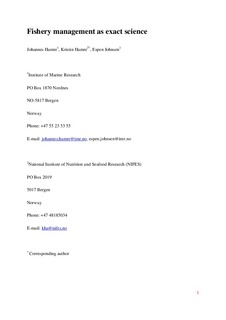| dc.contributor.author | Hamre, Johannes | |
| dc.contributor.author | Hamre, Kristin | |
| dc.contributor.author | Johnsen, Espen | |
| dc.date.accessioned | 2014-03-05T13:00:41Z | |
| dc.date.available | 2014-03-05T13:00:41Z | |
| dc.date.issued | 2014-03-05 | |
| dc.identifier.uri | http://hdl.handle.net/11250/191172 | |
| dc.description.abstract | The main objective in research on sustainable fishery management is to understand the effects of fisheries on the resources and predict the Maximal Sustainable Yield. The von Bertalanffy growth model, commonly used in stock assessment, is suboptimal for the calculation of yield, because it cannot be integrated to omit time from the equation. Here, we present a new model to be used as the scientific basis to calculate yield and provide advices for optimal ecological harvesting strategies. The model builds on the principle of exact science and utilizes population measurements from scientific acoustic trawl surveys as input in a real population dynamical model. The model expands the theory of relativity to include the transition of biomass into energy and will improve simulation models used in fisheries science. | nb_NO |
| dc.language.iso | eng | nb_NO |
| dc.publisher | Havforskningsinstituttet | |
| dc.subject | VDP::Landbruks- og Fiskerifag: 900::Fiskerifag: 920::Ressursbiologi: 921 | nb_NO |
| dc.subject | fisheries management | nb_NO |
| dc.subject | fiskeriforvaltning | nb_NO |
| dc.title | Fishery management as exact science | nb_NO |
| dc.type | Report | nb_NO |
| dc.subject.nsi | VDP::Mathematics and natural science: 400::Geosciences: 450::Oceanography: 452 | |
| dc.source.pagenumber | 12 s. | nb_NO |
